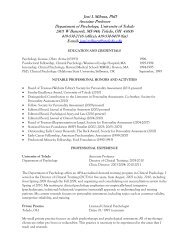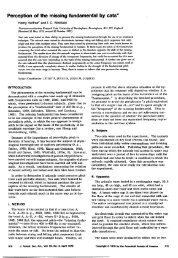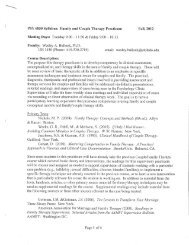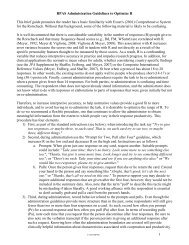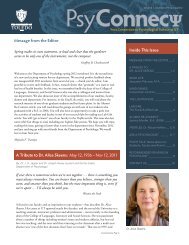The Rorschach Rating Scale: Item Adequacy, Scale ... - Psychology
The Rorschach Rating Scale: Item Adequacy, Scale ... - Psychology
The Rorschach Rating Scale: Item Adequacy, Scale ... - Psychology
- No tags were found...
You also want an ePaper? Increase the reach of your titles
YUMPU automatically turns print PDFs into web optimized ePapers that Google loves.
200 MEYER, BATES, GACONO1996). <strong>Item</strong>s were created to quantify variables from many scoring systems, includingthe Comprehensive System (Exner, 1993), the Lerner Defense <strong>Scale</strong>s (Lerner& Lerner, 1982), the <strong>Rorschach</strong> Defense <strong>Scale</strong>s (Cooper, Perry, & Arnow, 1988),the Psychoanalytic <strong>Rorschach</strong> Profile (Burke, Friedman, & Gorlitz, 1988), the EgoImpairment Index (Perry & Viglione, 1991), the Mutuality of Autonomy <strong>Scale</strong>(Tuber, 1992; Urist, 1977), Kwawer’s (1980) scores for primitive modes of relating(Gacono, Meloy, & Berg, 1992), Gacono and Meloy’s aggressive scores (Gacono& Meloy, 1994), and the <strong>Rorschach</strong> Oral Dependence <strong>Scale</strong> (Bornstein, 1993;Masling, Rabie, & Blondheim, 1967). Considerable effort was devoted to writingitems that were accurate verbal descriptions of the construct believed to be measuredby each <strong>Rorschach</strong> score (see Meyer, 1996a, for details regarding RRS development).Although the RRS was initially conceived as a scale to be completed byexperienced clinicians, it can also be used by other types of raters (e.g., spouses,parents, peers) or in a self-report format.<strong>The</strong> RRS is not intended to be a stand-alone assessment instrument. Rather, it isa tool to collect criterion data in <strong>Rorschach</strong> validation research. For instance, tovalidate the Comprehensive System’s Deviant Response score, the RRS containsthe criterion item, “Without clear external structure, or under the press of strongfeelings, this person’s thinking is loose, tangential, rambling, or flighty.” Similarly,to validate the Comprehensive System score for Vista responses, the RRScontains the item, “At least below the surface, this person is very self-critical andhas painful feelings about him/herself.” To validate a facet of Masling’s Oral Dependence<strong>Scale</strong>, the RRS contains the criterion item, “This person sees him/herselfas powerless and ineffectual. S/he believes others are stronger and have more controlof how situations turn out.” As a final example, to validate either Kwawer’s(1980) scoring for primitive modes of relating or the Psychoanalytic <strong>Rorschach</strong>Profile score for differentiated object relations, the RRS contains the item, “Thisperson establishes relationships that have a merged quality. S/he seems to losetouch with other people’s individual distinctiveness, identity, and personal motivations.”To minimize the confounds of method-specific variance, when the RRSis used in validation research, criterion ratings should be aggregated from severallay raters who know the patient well or from an expert clinician who has followedthe patient over time and familiarized himself or herself with all available informationabout the patient (Meyer, 1996a).Even though the RRS serves a focused purpose as a criterion instrument for<strong>Rorschach</strong> validation, research on both its psychometric and conceptual propertiesare desirable. Psychometrically, we sought to answer three questions: (a) Does theRRS contain items that are of little value for discriminating among people?, (b)Can the scale can be shortened by eliminating redundant items?, and (c) Whatlevel of reading skill is required to complete the scale accurately?We also address two theoretical issues. <strong>The</strong> first has practical implications forresearch employing the RRS; the second has a more abstract emphasis on modelsCopyright © 2000 All Rights Reserved



